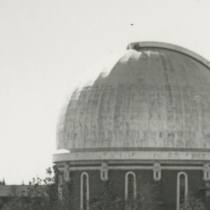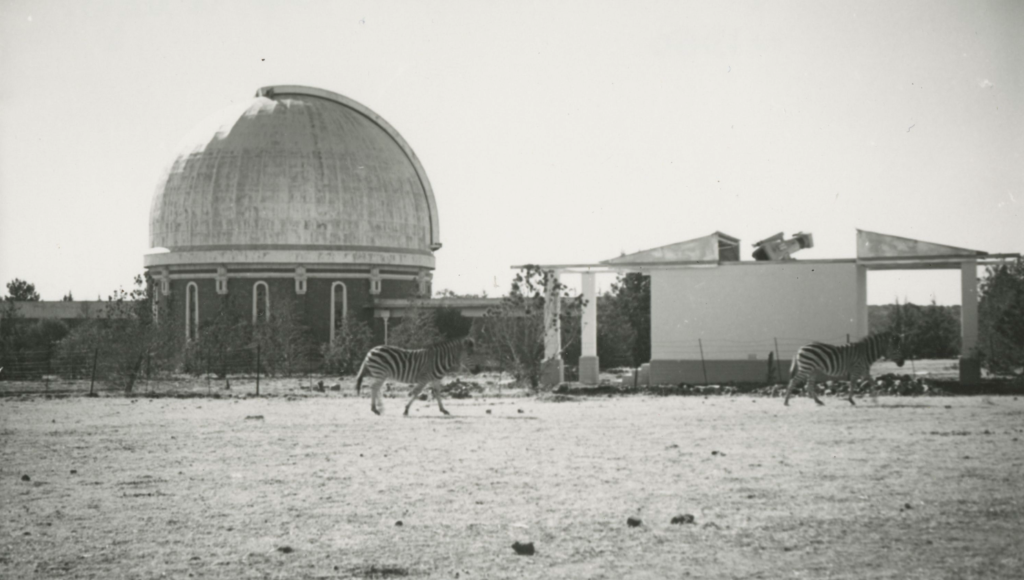Magazine

Between the Stars and the Sea
In the early 1900s, a determined professor of astronomy undertook the ambitious quest to build a new observatory abroad when U-M’s own observatory in Ann Arbor was threatened by a coal power plant. The result was an observatory in South Africa with U-M ties and a fascinating legacy.
By Julie Halpert
In 1926, William J. Hussey, a professor of astronomy at the University of Michigan, stopped off in London. He was headed to South Africa to oversee the construction of a new observatory—a long-held dream. But on October 28, he collapsed during dinner and died from a heart attack at the age of 64.
Hussey wouldn’t have ventured so far if he hadn’t been so angered by a decision by the University of Michigan Regents. His three-year quest to build an observatory in the Southern Hemisphere was prompted in large part by their insistence on building a coal power plant near the Detroit Observatory in Ann Arbor, despite his concerns that it would lead to pollution that would obscure stargazing.
“It meant that his dream of having a powerful observatory within walking distance of Central Campus where you could train students was largely at an end,” says Rudi Lindner, Professor Emeritus of history and astronomy, who has delved through volumes of historical data on Hussey resulting in a comprehensive article in the Journal of Astronomical History and Heritage titled “Rebuilding Astronomy at Michigan, from Hussey to Goldberg” (2003).
This sent Hussey on a mission to create a first-class observatory elsewhere, and he scoured the globe for the perfect location in the Southern Hemisphere—especially one he felt would be ideal for his work cataloging double stars (he would discover and measure 1,327 of them over the course of his career).
Opening as Planned
To build his dream, Hussey tapped the resources of his wealthy friend, Robert Lamont, a fellow engineering student at the University of Michigan, who became his benefactor.
One possibility for their new observatory was Argentina. But Lamont liked the idea of South Africa.

Zebras trot in front of the Lamont-Hussey Observatory in South Africa, which opened in 1928.
In 1923, Hussey headed there and settled on Naval Hill—a rural mountaintop in a town called Bloemfontein. The height kept it free from the lights and smoke of the city. Together, he and Lamont started building the Lamont-Hussey Observatory.
In 1926, Hussey, along with a younger colleague named Richard Rossiter, whom he recruited to work on the project, shipped a 27-inch refracting telescope to the future site in August. It was then the largest telescope south of the equator.
Things were progressing nicely until two months later when Hussey died in England. “It’s a great tragedy that Hussey died on his way to Africa,” Lindner says.
Lamont decided to proceed because they had already begun construction in South Africa. Freshly grieving, Lamont saw the project to completion along with Rossiter, who understood Hussey’s vision.
The Lamont-Hussey Observatory opened as planned in South Africa in 1928. Rossiter was its director until 1952.
Rossiter managed to continuously resuscitate the observatory throughout the years when circumstances were particularly dire, including during the Great Depression. Lamont, who was Secretary of Commerce in the Hoover administration, found he could no longer continue to bootstrap it. The University of Michigan couldn’t be counted on to swoop in and rescue it, either. State revenues had fallen, causing severe cuts in the University’s budget.
Rossiter’s ingenuity ultimately saved the day. He secured funding from the city of Bloemfontein and the Union Government. Ultimately, the University of Michigan started providing half of the financial support beginning in 1944 and assumed full financial support in 1952.
A Determined Visionary
The University of Michigan ultimately closed the Lamont-Hussey Observatory in the 1970s as a political response to Apartheid in South Africa. Patrick Seitzer, Professor Emeritus of astronomy explains that other factors led to its demise as well. At the time, there was little interest in double-star observations among the faculty. The University also had a far more scientifically productive telescope in Chile. “A 27-inch visual refractor had little scientific potential going forward,” Seitzer says.
Though he felt the University could have handled the power plant situation better, Lindner said that Hussey would have always wanted to build the southern station and that the Detroit Observatory ultimately had significant limitations. Hussey couldn’t have imagined that the city would expand to the east—sprouting dorms and a hospital. “The future of astronomy rested on sites that had good weather above the clouds and calm atmosphere, and there was no place like that east of the Rockies,” Lindner says. “In the end, with the increase in urbanization, it just wasn’t going to work out.”
Seitzer says that the University decided to return the refractor lens from South Africa back to Ann Arbor, thinking it could be used somewhere else, but no use ever came of it. It’s still in storage on Central Campus.
After the Lamont-Hussey Observatory closed and the telescope was dismantled, parts of the refractor were on display at the Ehrlich Park Fire Station Museum in Bloemfontein until it was re-erected as a sculpture outside the Lamont-Hussey building. “I don’t think the [telescope and the refractor] will ever get together again,” Seitzer says.
After it closed as an observatory, The Lamont-Hussey space was initially used as a theater for local productions, Seitzer says. In 2013, money was provided from within South Africa to convert it into a digital planetarium. Seitzer was there for the inauguration in November 2013. “It was the first digital planetarium in southern Africa and sets the standards for many others to follow,” he says.
Seitzer adds that the observatory in South Africa became an important legacy for Hussey. More than 5,530 double stars were discovered there. Later, the 27-inch refractor would be used for studies of Mars, including taking some of the first color pictures of the “red planet.”
“Hussey really brought Michigan astronomy into the 20th century,” Seitzer says.
Lindner adds, “He was a determined visionary. And his vision for a future of astronomy in the Southern Hemisphere is an important legacy.”
